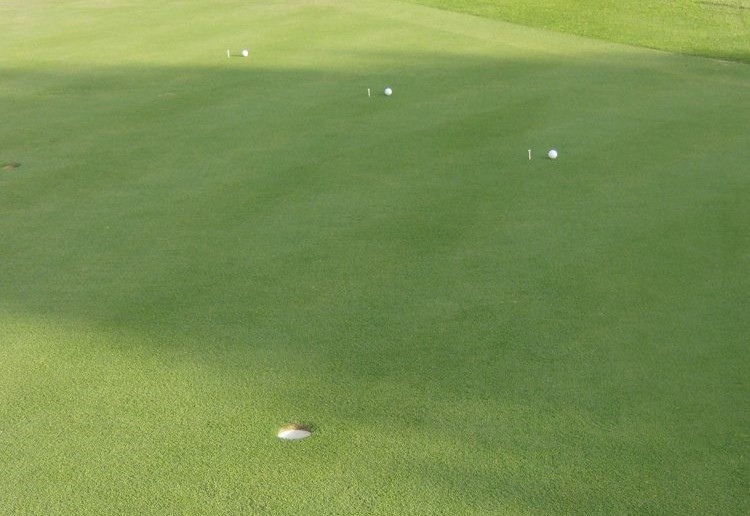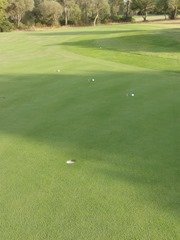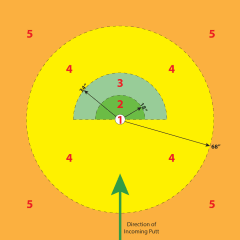This is a great game for improving your putting touch in the 20- to 30-foot (6-9m) range – a range where you need to have great distance control in order to give yourself a chance of making the occasional putt, while being sure to minimise your chances of three-putting.
No one, not even the world’s best putters, will ever make many putts from this range. Rolling over 20’ of grass exposes the ball to so many green surface irregularities, even on the very best of greens, that, no matter how good your putting skills are, you are always at the mercy of mother luck.
Because of this, no matter how hard you practise, you’ll never be able to aim these putts with any certainty. You can, however, improve you ability to read the speed of these putts and learn how to precisely control the distance that you roll the ball. When you do this, your chances of three-putting are greatly reduced, and your scores will improve significantly.
How to Play
To play the Intermediate Putt Touch game, do the following:
Figure 1. Setup for the Intermediate Putt Touch game.
- Choose a hole on the practice green where you can play 30’ (9m) putts from two different directions.
- Don’t choose a hole and line that will give you a break of more than 3’, or that is severely downhill. Instead, look for a line that will test your putting ability for the putts that you most often expect to encounter on the golf course.
- Mark 3 points on the green with tees, at 20, 25 and 30 feet (6, 7.5 and 9m) from the hole. Stagger the points so that you won’t have to roll the longer putts over the footprints you leave when playing the shorter putts – see Figure 1.
- Mark 3 more points at the same distances in another direction away from the hole.
- Play a putt from each of the six points you’ve marked, starting at each of the 25-foot marks, then 30- and 20-foot putts.
- Repeat, playing a total of 12 putts, two from each point.
It is important that you perform your full pre- and post-shot routine for every putt. Go through your green reading process, take your time to visualise the stroke, practise your quiet eye technique, try the right amount and react to the target. Use your post-shot routine to actively build your self-image and learn from your mistakes.
With a little practice, you’ll quickly learn how to measure out the distances fairly accurately. As a guide, for an adult male of average build, 20 feet is 7 large strides minus 1 foot.
Scoring
Always record your score in your practice session log, and try to beat your best score each time you play this game. The competitive edge is crucial.
Figure 2. Putting game scoring chart.
Score each putt as follows (see Figure 2) – it’s easier than it might sound, just keep track of how you are doing versus “par”:
- Holed putts count as 1 stroke (1 under par)
- Putts that roll past the hole but stop within 18” (45cm) of the hole count as par, 2 strokes.
- Putts that roll past the hole more than 18” but stop within a standard putter length (34”, 86cm) of the hole count as 3 strokes.
- Putts that don’t meet the above criteria and stop within 2 putter lengths score 4 strokes, and 2 putter lengths or more from the hole is 5 strokes.
So a par score is 24, and the best possible score is 12. Any score above 45 is poor, indicating that you need to work hard at improving from this range, and that you have a lot to gain by doing so. A world-class putter would expect to score 30 or less.
The inner semicircle of 18” past the hole is the area you should always try to leave missed putts. At the speed required to leave them here, they have the best possible chance of dropping in the hole, while still enabling the putt to stay on line close to the hole. Play the putt faster than this, into the 3-point zone, and you increase your risk of lipping out. Faster still, 4 points or more, and you will leave yourself a testing second putt. And, for obvious reasons, leaving putts short is always costly.
If the ball lips out and comes back towards you, it counts as if it was past the hole – so within 18” scores 2. Even though, strictly speaking, the ball stopped on the short side of the hole, the pace was good.
When playing this game, you should be paying full attention and trying your best to shoot a low score.
How to Compete
This is a great game to play against a partner in match play format, and it should only take about ten minutes.
Toss a coin to determine who plays first, then both players play from the first point. Second putts are not putted out. The winner of each putt is the person who gets the lowest score. Play then moves onto the next point, where the winner of the last hole gets the honour.
This game forms part of the Golf Loopy Putt like a Champion series, the sensational new putting game improvement system that will help you to improve every aspect of your performance on the greens. The improvements will be dramatic, and they will be permanent.






